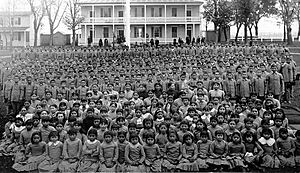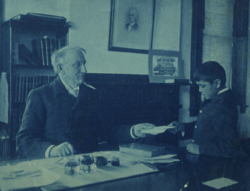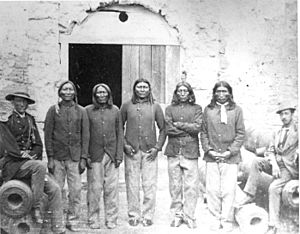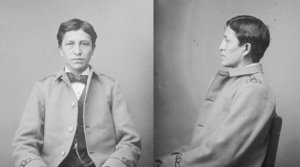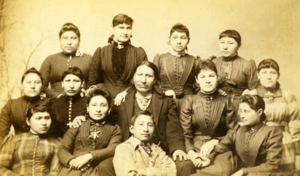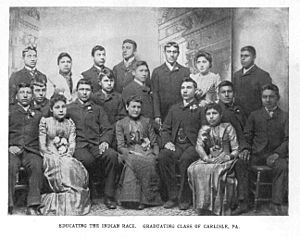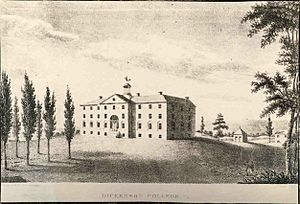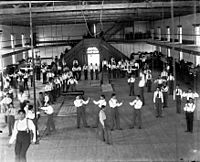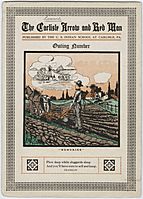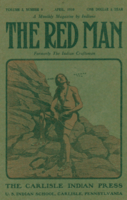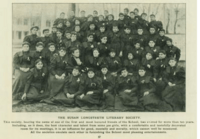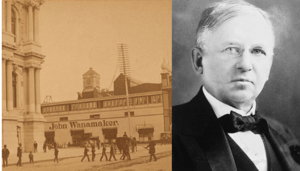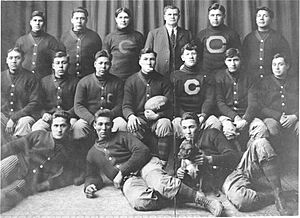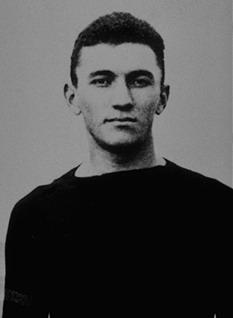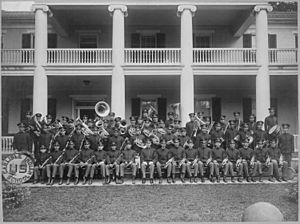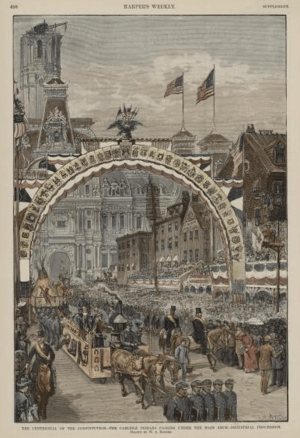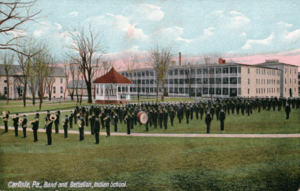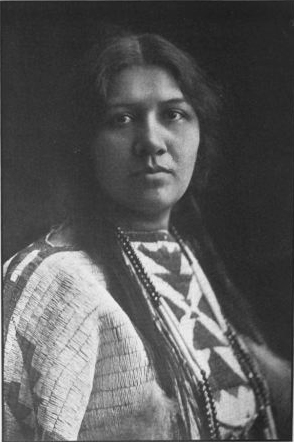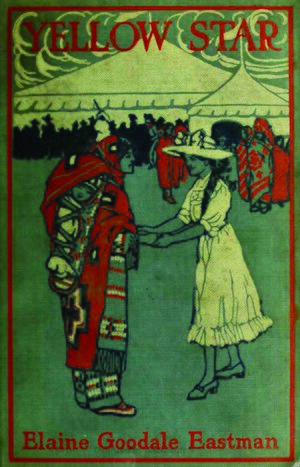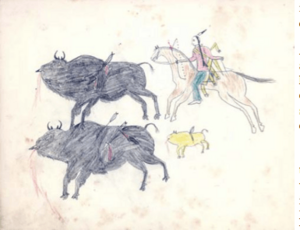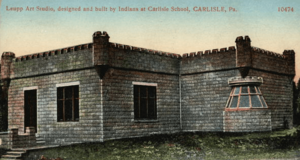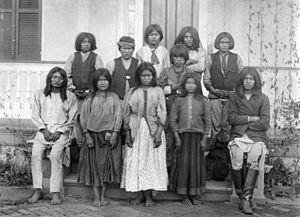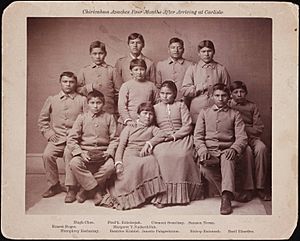Carlisle Indian Industrial School facts for kids
|
Carlisle Indian Industrial School
|
|
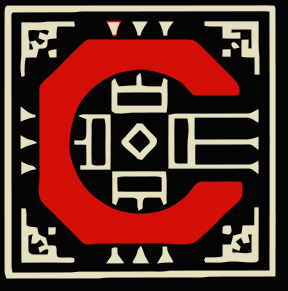
Carlisle Indian School logo
|
|
| Lua error in Module:Location_map at line 420: attempt to index field 'wikibase' (a nil value). | |
| Location | 122 Forbes Ave Carlisle, Pennsylvania |
|---|---|
| Area | 24.5 acres (9.9 ha) |
| Built | 1757 and after |
| Architectural style | Colonial Revival |
| NRHP reference No. | 66000658 |
Quick facts for kids Significant dates |
|
| Added to NRHP | October 15, 1966 |
| Designated NHL | July 4, 1961 |
The Carlisle Indian Industrial School was a famous boarding school in Carlisle, Pennsylvania. It operated from 1879 to 1918 and was the first school of its kind funded by the U.S. government that was not on a reservation. It was built on the historic Carlisle Barracks, which is now part of the U.S. Army War College.
The school was founded in 1879 by Lieutenant Richard Henry Pratt. His goal was to help Native American children learn to live in mainstream American society. Pratt believed that Native Americans were equal to European-Americans. He thought that by teaching them English, new skills, and customs, they could succeed and become leaders for their own people. His motto was "Kill the Indian, save the man," meaning he wanted students to give up their traditional Native American ways and adopt American culture.
Carlisle became a model for many other off-reservation boarding schools across the United States. Over 10,000 Native American children from 140 different tribes attended Carlisle during its years of operation. Some of the largest groups of students came from the Lakota, Ojibwe, Cherokee, Apache, Cheyenne, Alaska Native, and Iroquois tribes.
The school's policies and practices have been seen as controversial, especially in recent times. Many people now believe that forcing Native American children to give up their culture was harmful.
Contents
Founding the School
Richard Henry Pratt's Vision
Before Carlisle, Richard Henry Pratt worked with Native American prisoners of war in Florida in the 1870s. He taught them English, art, and useful skills. This program became well-known, and many important visitors came to see it.
Pratt believed that "distant education" was the best way to help Native Americans fit into American society. He thought that if Native American children grew up in a different environment, they would learn new languages and habits. He believed that all people were equal and should have equal chances in society.
Pratt thought that a school like the Hampton Institute, which taught practical skills, would be good for Native Americans. He successfully convinced the government to open a boarding school for Native Americans at the empty Carlisle Barracks in Carlisle, Pennsylvania.
Opening Day at Carlisle
In October 1879, Lieutenant Pratt brought the first students to Carlisle. Eighty-two boys and girls arrived late one night and were met by many local people. The Carlisle Indian School officially opened on November 1, 1879, with 147 students. Most were teenagers, but some were as young as six or as old as twenty-five. Many of the first students were children of Plains Indian leaders, including Lakota, Cheyenne, Kiowa, Pawnee, and Apache. Some had even been prisoners with Pratt at Fort Marion and wanted to continue their education.
The U.S. government wanted to quickly help Native Americans adapt to white culture. Pratt believed Carlisle was the perfect place for this. He also thought being close to officials in Washington, D.C., would help him show them that Native Americans could learn and succeed.
Life at Carlisle School
Life at Carlisle was very different from what most students were used to. They had to learn English, and school officials made them choose new English names. For example, Luther Standing Bear, one of the first students, was asked to pick a name from a list and chose "Luther." His father's name, Standing Bear, became his last name.
Students also had to change their appearance. Boys' long hair, which was important in their cultures, was cut short. Everyone had to wear American-style school uniforms.
Luther Standing Bear later wrote about how uncomfortable the new clothes were. He said that the "civilizing process" started with clothes because white people believed Native children couldn't be civilized in their traditional clothing. He especially remembered the red flannel underwear as "actual torture."
Older students who already spoke some English often helped as translators. School discipline was very strict, like in the military. Students could even face 'courts-martial' for serious rule-breaking. Some children found it hard to adjust and either returned home or ran away.
Getting Students to Come
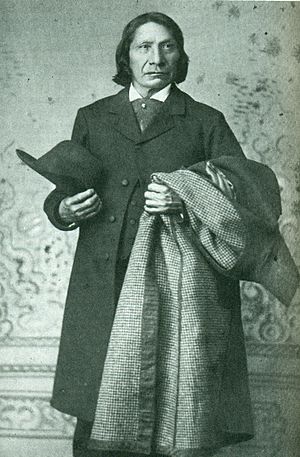
In 1878, Pratt was sent to the Dakota Territory to recruit students. He focused on tribes like the Lakota, Dakota, and Nakota, who had resisted giving up their land. The government believed that by taking their children to school, they would have more power over the tribes. Pratt even said the children would be "hostages for the good behavior of the people."
Pratt convinced tribal leaders, like Chief Spotted Tail, that Native Americans were at a disadvantage because they couldn't read or write English. He argued that if they were educated, they could protect their land and rights better. Spotted Tail, who had been tricked into signing treaties, agreed to send his children.
Sometimes, tribes agreed to send children only if they could visit the school later. Many chiefs visited Carlisle and then Washington, D.C., where government officials praised them for supporting the school.
However, communication with families was often cut off once students were at school. Parents sometimes didn't get letters, and they weren't always told quickly if their children died. Although a law from 1819 said parents had to agree to send their children to these schools, children were often taken by force. This was because white officials thought Native American parenting was not good enough. This forced removal of children was made legal in 1891 and only stopped with the Indian Child Welfare Act in 1976.
American Horse and the School
Oglala Lakota Chief American Horse was one of the first Native leaders to support Western education. He believed his children would need to deal with white people and decided to send two sons and a daughter to Carlisle's first class.
A Model School
Carlisle became very well-known. Many Western chiefs asked Pratt to take more of their children. News of the school spread, and many people volunteered to help. Pratt used photographs to show the school's progress. Photographers like John Nicolas Choate took "before and after" pictures of students, showing their transformation from traditional Native dress to military uniforms and short hair. These photos were sent to government officials and donors to show the school's success and to recruit new students.
Students had to be at least 14 years old and at least one-fourth Native American. The program usually lasted five years. Pratt would only send students home early if they were sick or caused problems.
Between 1899 and 1904, Carlisle gave out 30 to 45 diplomas each year. Many graduates found jobs in government service or off reservations. Important people like senators and college presidents often visited the school and spoke at graduation ceremonies.
Carlisle Community Connections
Carlisle, Pennsylvania
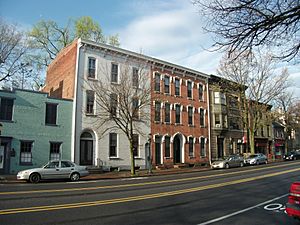
In 1880, Carlisle, Pennsylvania, was a busy town with over 6,000 people. It had factories, railroads, banks, and hotels. It was chosen as the school's location because it was not a big city, but also not so far west that students could easily run away. The historic Carlisle Barracks were empty and available.
When the first Native American students arrived in Carlisle in 1879, they wore their traditional tribal clothes. The townspeople gathered to watch. The students often sang to keep their spirits up, even though they were scared. The townspeople often cheered for the school's famous football team, the "Carlisle Indians."
Dickinson College's Role
Carlisle was also home to Dickinson College, one of America's oldest colleges. Dickinson College and the Carlisle Indian School worked together for nearly 40 years. The president of Dickinson College, Dr. James Andrew McCauley, led the first worship service at the Indian School. He became an important advisor and friend to the school.
Dickinson College professors served as chaplains and special teachers at the Indian School. College students volunteered and participated in events. Carlisle students could also attend Dickinson's preparatory school and even college-level classes. A few Carlisle graduates later attended Dickinson Law School.
Professors from Dickinson College, like Charles Francis Himes, gave interesting lectures to the Carlisle students, even to chiefs like Red Cloud. He also brought students to the college's science lab.
School Programs
Classes and Activities
Carlisle's classes included English, math, history, drawing, and writing. Students also learned trade skills like farming and manufacturing. Older students even helped build new classrooms and dorms. The school published weekly and monthly newspapers, which helped students learn about working in publishing.
Music was a big part of the program. Many students learned classical instruments, and the Carlisle Indian Band became famous around the world. Native American teachers, like Ho-Chunk artist Angel De Cora, taught students about Native American art and heritage.
Students were taught Christianity and could choose which local church to attend. They also had to go to daily and Sunday services. There were many clubs and activities, like the YMCA, King's Daughters Circle, and various literary and debating societies.
A summer camp was set up in the mountains where students lived in tents, picked berries, hunted, and fished. Luther Standing Bear remembered how they made bows and arrows and shot at money placed on sticks for visitors. This brought a "real home thrill" to them.
Summer Outing Program
The Carlisle Summer Outing Program allowed students to work in homes, farms, or businesses during the summer. This program was praised because it showed that Native Americans could be educated and fit into society. It also gave students a chance to live and work in the white world and earn their first wages. Many students worked for Quaker families in Pennsylvania and nearby states.
Students had to write home at least once a month. Many sent money they earned to their families. Maggie Stands Looking, daughter of Chief American Horse, was one of Captain Pratt's best students. She struggled at first but learned to adapt. She wrote to Pratt about her experiences working in a country home without a bath, and he advised her to make do, which she did.
The Outing Program continued throughout the school's history. Later, boys were placed in manufacturing companies like Ford Motor Company. Many Carlisle boys were hired by Ford, and during World War I, some worked in shipyards.
Student Internships
In 1883, Luther Standing Bear interned at Wanamaker's, a large department store in Philadelphia. Pratt told him to work hard and prove that Native Americans were not lazy or dirty. Luther did so well that he was promoted quickly. At the end of his internship, John Wanamaker himself praised Luther's work to the entire Carlisle school.
The "Carlisle Indians" Sports Teams
In the early 1900s, the Carlisle Indian School had a nationally famous football team. They often played against major college teams like Harvard and Yale. Coach Pop Warner led the team and helped develop new football strategies, like the forward pass. He coached the amazing athlete Jim Thorpe, who brought national attention to the school.
In 1911, the Carlisle Indians had a great season, including a famous upset win against Harvard. Jim Thorpe scored all the points for Carlisle in that game. The Carlisle Indians were known for their innovative plays and were even called the "team that invented football."
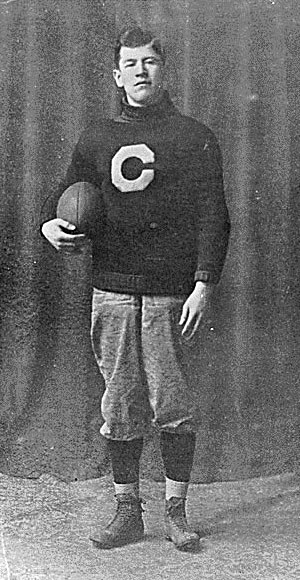
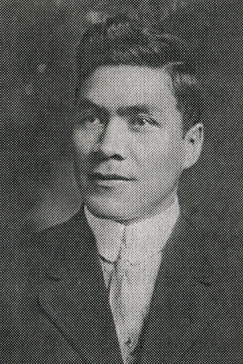
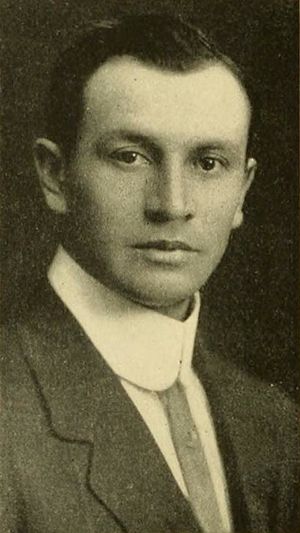
In 1912, Carlisle played the U.S. Military Academy (Army). Coach Warner told his team, "These men playing against you today are soldiers. They are the Long Knives. You are Indians. Tonight, we will know if you are warriors." Carlisle won the game 27–6. This game was especially meaningful because it happened just 22 years after the Wounded Knee Massacre. Many Carlisle players, including Jim Thorpe, became professional athletes, coaches, and community leaders.
The Carlisle Indian Band
The Carlisle Indian Band became internationally famous under its leader, Dennison Wheelock, an Oneida musician. Many students learned classical instruments. The band performed at world fairs, exhibitions, and every national presidential inauguration until the school closed. Luther Standing Bear was a bugler and classical musician. In 1883, he led the band as the first group to cross the Brooklyn Bridge on its opening day.
Zitkala-Ša, a talented violinist, taught music at Carlisle and debated how Native Americans were treated. She performed with the Carlisle Indian Band at the Paris Exposition in 1900. She also wrote articles about Native American life for popular magazines. However, she disagreed with Pratt's strict assimilation methods and was dismissed from the school. She dedicated her life to fighting for Native American rights, voting rights, and education.
Native American Arts Program
From 1904 to 1909, Francis E. Leupp, the Commissioner of Indian Affairs, encouraged teaching Native American culture at Carlisle. He believed it was wrong to try to make Native Americans into white people. He said, "The Indian is a natural warrior, a natural logician, a natural artist."
In 1906, Leupp hired Angel De Cora, a Ho-Chunk artist, to teach the first Native arts course at Carlisle. She insisted on teaching Native art in a way that respected her own culture. In 1907, students built the Leupp Indian Art Studio to show and sell student artwork, including paintings, drawings, leatherwork, and jewelry. The money from sales helped people on reservations and made the public more interested in Native crafts.
In 1908, Angel De Cora married Lone Star Dietz, a Carlisle student and assistant art teacher. They created cover designs for the school's literary magazine, The Indian Craftsman, which later became The Red Man. They helped students learn about their culture through their art programs.
Historical Context
Native Americans in Public Shows
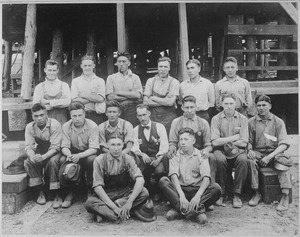
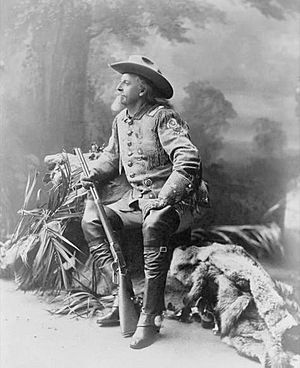
During the late 1800s and early 1900s, there was a lot of public interest in Native American culture. "Wild West" shows, like Buffalo Bill Cody's, were very popular. These shows often presented Native Americans as "vanishing" or as stereotypes.
Some reformers, including Richard Pratt, disagreed with these shows. They believed the shows exploited Native Americans and showed them in a bad light. However, Buffalo Bill Cody believed Native Americans should be allowed to keep their culture and change at their own pace. He also thought they were equal to white people. Pratt even invited Buffalo Bill's show to perform at Carlisle in 1898.
Many Carlisle students, especially Lakota, had family and friends who performed in these "Wild West" shows. These performers were sometimes called Oskate Wicasa, meaning "one who performs" or "Show Man," which was a title of great respect. Being a "Wild Wester" offered adventure, pay, and opportunities.
Society of American Indians
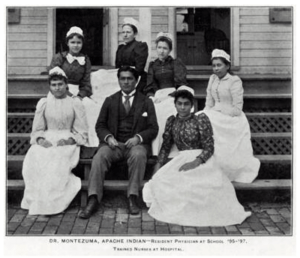
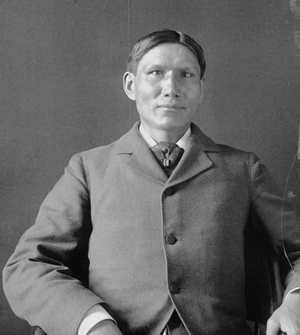
The Carlisle Indian School played a role in the creation of the Society of American Indians. This was the first organization for Native American rights created by and for Native Americans. It was a group of about 50 important Native American thinkers who wanted to preserve Native American culture and fight for self-determination. They worked for Native American citizenship and the Indian Citizenship Act of 1924.
Founding members included Dr. Carlos Montezuma, Dr. Charles Eastman, Angel De Cora, and Zitkala-Ša. Many of these leaders had connections to Carlisle.
Closing and Legacy
Pratt's Retirement
Pratt often disagreed with government officials because he openly spoke about the need for Native Americans to assimilate. In 1903, he criticized the Bureau of Indian Affairs and the reservation system, saying they hindered Native American progress. Because of this, Pratt was forced to retire from Carlisle after 24 years. He continued to advocate for Native American rights until his death in 1924. His memorial stone in Arlington National Cemetery says, "Erected In Loving Memory by his Students and Other Indians."
Assimilation at Carlisle
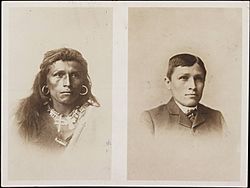
Carlisle's main goal was to make Native Americans part of mainstream American culture. Pratt believed in "total immersion" in the white world. His approach was strict, but it was seen as an alternative to the idea of simply eliminating Native Americans. A positive outcome was that students often learned to speak English very well.
However, students were forced to give up their cultural traditions. This included cutting their hair, changing their clothes, diets, and names. They also had to change their traditional gender roles. In many Native cultures, women held important political and economic power, but at Carlisle, they were taught only domestic skills. This cultural change often led to confusion, homesickness, and anger.
To encourage English learning, only English was allowed on campus. Students from the same tribe were not allowed to room together. This helped them learn English quickly, but it also separated them from their cultural groups. Some Native Americans are still angry about the painful experiences at these boarding schools.
Returning Home
When students returned to their reservations, they often faced mixed reactions. Some relatives were proud of their achievements, but others felt they had "become a white man." Some students were ashamed of their own culture, while others pretended not to speak their native language.
Many returning students felt caught between two cultures, not fully accepted by either. Some rejected their education and went back to traditional ways. Others found it easier to stay in white society. Most learned to live in both worlds.
Luther Standing Bear eventually left the reservation because he didn't want to live under government control. He moved to California and became a notable Native American author, educator, and actor. He continued to fight to preserve Lakota heritage.
Health Challenges
Many children at Carlisle died from infectious diseases like tuberculosis, which were common in the early 1900s. More than 180 students were buried in the Carlisle Indian School Cemetery. Bodies of children who died from tuberculosis were buried at the school to prevent the spread of disease.
Carlisle's Final Years
After the early 1900s, Carlisle became less important. More local schools opened on reservations, so children didn't need to travel far. The school faced problems with its leaders and pressure from the government. By 1913, rumors spread that the school would close.
In 1914, a government investigation looked into the school's management and its focus on sports. Coach Pop Warner and other leaders were dismissed. Attendance dropped, and morale declined.
When the United States entered World War I in 1917, even fewer students enrolled. Many Carlisle alumni and students served in the war. On September 1, 1918, the Carlisle Indian School closed. The property became U.S. Army Base Hospital Number 31, a hospital for wounded soldiers. Remaining students were sent home or to other boarding schools. In 1951, the U.S. Army War College moved to the old Carlisle Barracks.
Remembering Carlisle Today
U.S. Army Heritage and Education Center
The U.S. Army Heritage and Education Center (USAHEC) in Carlisle, Pennsylvania, is the U.S. Army's main historical research center. It has a large collection of Army history materials and is part of the U.S. Army War College.
U.S. Army War College—Jim Thorpe Sports Day
Jim Thorpe Sports Day is the biggest annual event at the U.S. Army War College. Started in 1974, it's a sports competition among military schools. The games are played at Carlisle Barracks' historic Indian Field, where Jim Thorpe once played. This event honors his teamwork and fitness.
Cumberland County Historical Society
The Cumberland County Historical Society in Carlisle, Pennsylvania, keeps many records and photos from the Carlisle Indian Industrial School. This includes school newspapers, programs, letters, and oral histories from former students and local people. In 2000, the community worked with Native Americans to hold a "Pow-wow" to remember the school, its students, and their stories.
Carlisle Indian School Digital Resource Center
The Carlisle Indian School Digital Resource Center is an online collection of materials about the school. It's run by Dickinson College and brings together documents from various places, including the National Archives and Records Administration. This project helps people learn more about the school's history.
Carlisle in Media
- Band and Battalion of the U.S. Indian School (1901) is a silent film showing a parade drill by the school's cadet corps.
- The 1951 movie Jim Thorpe – All-American tells the story of Jim Thorpe and his time at Carlisle. Burt Lancaster played Thorpe, and Charles Bickford played Coach Pop Warner.
- Part of the 2005 TV mini-series Into the West takes place at the school.
- The PBS documentary In the White Man's Image (1992) tells the story of Richard Pratt and the school's founding.
- The young adult book My Heart Is on the Ground by Ann Rinaldi (1999) is a fictional diary about a Sioux girl sent to the school in 1880.
- The memoir Apple: Skin to the Core by Eric Gansworth (2020) uses poems and images to share the author's family history, including his grandparents' experiences at Carlisle.
Images for kids
-
Lieutenant Pratt and Southern Plains veterans of the Red River War at Fort Marion, Florida, 1875. Several of these later attended college.
See also
 In Spanish: Carlisle Indian Industrial School para niños
In Spanish: Carlisle Indian Industrial School para niños


